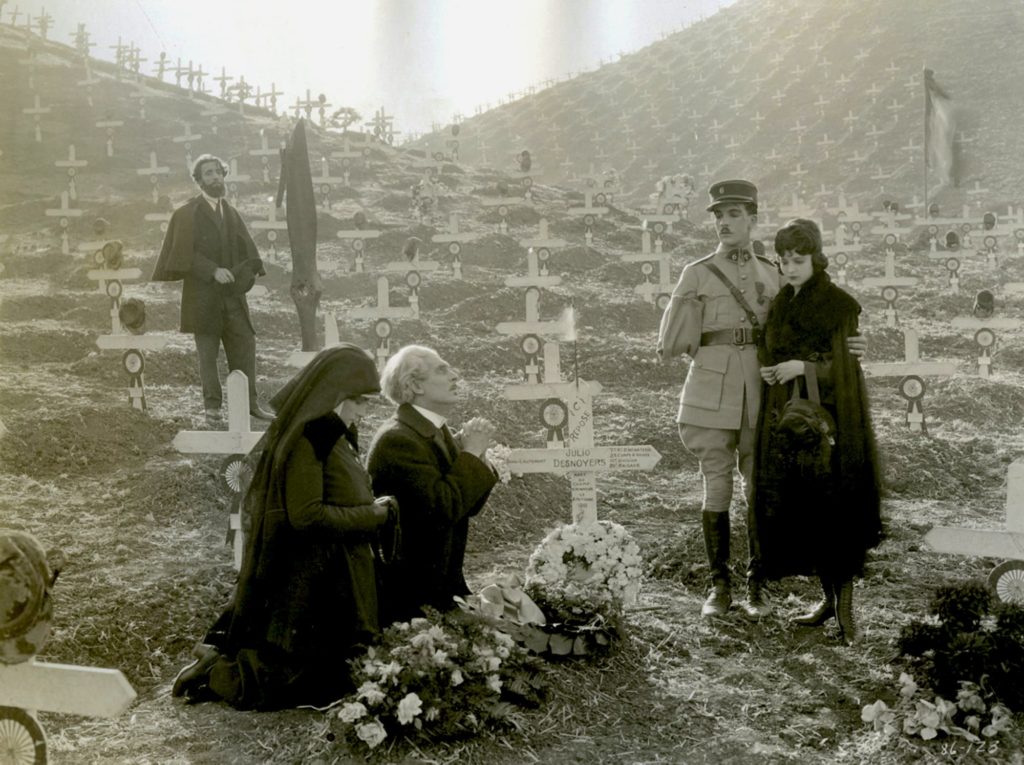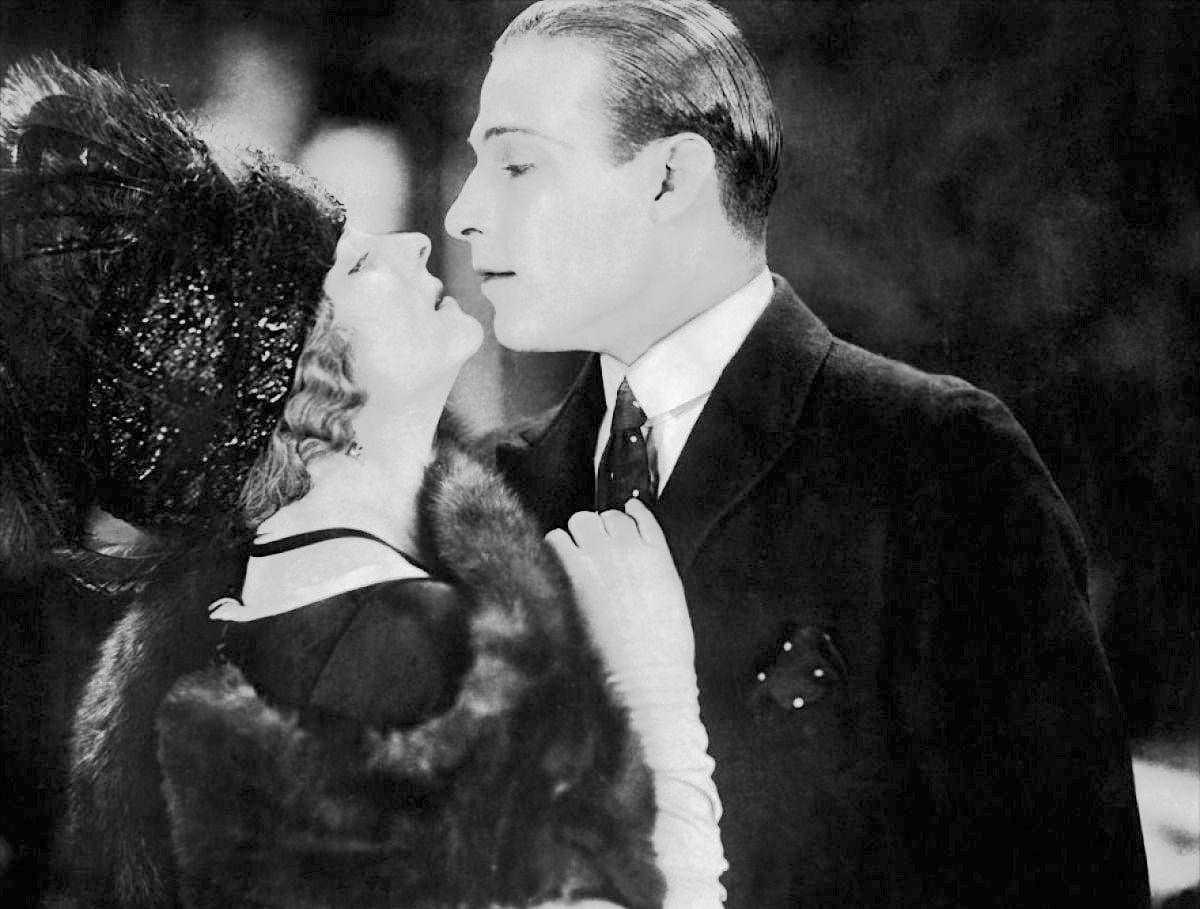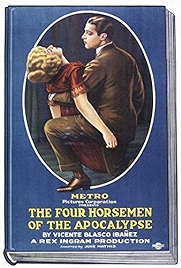The Four Horsemen of the Apocalypse was the first of five films Rudolph Valentino made in 1921 and though it’s the film that made him a star he’s not the star of the film, which is an ensemble piece. The star is the film itself, an epic so complete and fine-tuned that it’s a reference point today whenever producers and directors are aiming to tell tender human stories against a background of raging conflict.
It’s a big film too – two and a half hours long, which isn’t gargantuan compared to, say, Birth of a Nation (three and a quarter hours) or Greed (originally four and a half hours) – but surprises people who think that silent movies are all Charlie Chaplin or Laurel and Hardy length. Big in length and in sweep, it straddles continents and generations to tell the story of a Spanish rancher who makes his fortune in Argentina and marries his daughters off – one to the Frenchman Desnoyers (Josef Swickard), the other to the German Von Hartrott (Alan Hale). They in turn reproduce and move back to Europe just in time for their children to come of age and become embroiled in the First World War, on opposing sides.
1921 was only three years after the end of the First World War and this film is clearly on the side of the Desnoyers, a cultured family, rather than the Von Hartrotts, an absurdly Teutonic and ramrod Prussian lot. Even so, the Desnoyers are not without their foibles. The father of the clan is a vain man given to hoarding, the son Julio (played by Valentino) is a libertine who frequents the tango bars, hangs out with scantily clad women and is running through the family wealth with a playboy lifestyle that’s indulged by his mother and tolerated by his sister.
In the sort of plot development Steve Bannon would doubtless applaud, war arrives and purifies all of them, forcing the Desnoyers to appraise themselves and to realise there’s more to life than vanity, that the appeals of country must sometimes be heard, and that obeying them will make those who respond nobler and better human beings.
Conflict is always in the offing in this film, director Rex Ingram, one of the big five or six creative talents at work in Hollywood at the time, foreshadowing unpleasantness to come with incidental spats happening off in the wings – a cockatoo defends its perch against a pet monkey, a cat takes a swipe at a dog, a cyclist and a pedestrian come to blows. The film is brilliantly constructed in fact. Lit by John Seitz, working up to full legendary status here, it’s edited by Grant Whytock to take in Ingram’s many changes of mood – even at moments of high seriousness there’s often a moment of low comedy to keep the entertainment factor high (that monkey again).

It’s a bit heavy on the intertitle cards, admittedly, but then Ingram is trying to get a lot in, in terms of plot, people and places. Once the action has moved to Europe we’re either in Paris or down on the Marne at the Desnoyers’ glorious chateau, with the men marching to war or out on the battlefield. The story dives off in different directions – Julio’s dalliance with a married woman (Alice Terry, with whom director Ingram was in fact dallying), her stiff older husband (John St Polis), Julio’s louche manservant and the Rasputin-like Serbian who lives upstairs, the sister, the mother. Ingram choregraphs each scene as if it were a dance piece, the actors moving beautifully into position and, most unusually, not overdoing the silent movie theatricality (back of hand to head, insane glower, swoon etc).
Ingram was initially a sculptor and had no interest in the biz end of showbiz. Indeed when the talkies came in, he couldn’t be bothered refitting the studio in the south of France where he’d set up shop and instead gave up making films altogether. That’s where he met the young Michael Powell, who says he learned a lot about the use of fantasy from Ingram. There isn’t a massive amount of it here, though in grand apocalyptic style the Four Horsemen from the Bible’s Book of Revelations – Conflict, War, Pestilence and Death – are all introduced individually in a fantasy sequence that must have been knuckle-whitening originally.
In the restoration I watched (the one you’ll catch on TCM most likely), Carl Davis provides the score. It doesn’t catch all of Ingram’s darting digressions of mood but it is a superbly big score with a Shostakovich-like sweep and roar.
As to Valentino, this is the film that made him a star and it’s in the scenes with women – dancing in the tango bar, painting naked models in his studio, romancing the married Mme Laurier – that you can see why he caused a stir. Keep an eye on his clothes. Apart from the obvious costumes provided for him, like the gaucho outfit, the rest he had made specially and paid for them himself. Though he’s a bit of a tailor’s dummy, they are, like the film, impeccably well made.
Will no one make a 4K restoration of this superb film? I’m writing this at the end of its centenary year, so the answer, for the moment at least, would appear to be “no”.
The Four Horsemen of the Apocalypse – Watch it/buy it at Amazon
I am an Amazon affiliate
© Steve Morrissey 2021

